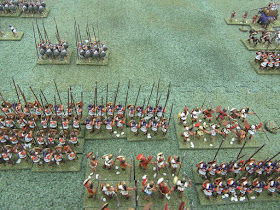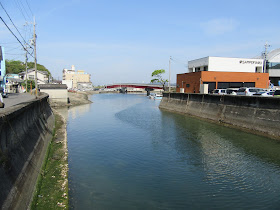This year's Society of Ancients
battle day (traditionally held on the first weekend of April) took Paraitakene as its subject. The battle day, organised by the tireless Richard Lockwood, is about getting as many Society members as possible together at one venue (though gathering elsewhere is also encouraged if getting to the venue is impossible) to discuss the battle and play it out on the table using different rules sets. It's a good occasion and a great example of what the Society is all about.
As I'm in Japan I wasn't able to get to the venue, but I did get a Paraitakane of my own in on Monday. As time was short, I used the tried-and-true
Lost Battles rules, though I would also have liked to have experimented with
To the Strongest,
Scutarii or a modified
Dux Bellorum.
Anyway, here's a quick report.
The armies deploy, both strengthening their right wings.
 |
| Eumenes' centre and refused left. |
Eumenes has more elephants and the edge in heavy infantry quality thanks to the veteran Silver Shields, but Antigonus has the advantage in cavalry.
 |
| Antigonus' centre: phalangites and peltasts. |
 |
| Eumenes' refused left. |
 |
| Antigonus' right: a formidable strike force of veteran cavalry. |
 |
| The brave light cavalry on Antigonus' left. |
 |
| The entire battlefield: Eumenes to the left; Antigonus to the right. |
During the second turn, in order to achieve a decisive advantage on the right flank, Eumenes redeploys the light cavalry from his left to the right. This weakens his left even further, but he feels it is a risk worth taking to expedite the defeat of Antigonus' left and the rolling up of the enemy centre.
Antigonus advances all along the line, but pulls back the cavalry on his left to delay the first onset, reinforcing that wing with more heavy cavalry taken from his centre left.
 |
| The two centres meet. |
 |
| The field. |
The fight would be a true revolving door battle: a race to break the enemy's right and expose the centre.
The two centres commence the struggle, with both sides having some success in the central zone, but with Antigonus making no progress on the left.
Both strong wings bully their weaker opponents, with some thrilling exchanges as 'Favour of the Gods' changes hands, either averting catastrophe or pushing again for a breakthrough.
 |
| The centres locked in combat. |
 |
| Antigonus presses forward inexorably on his right. |
Seizing the moment, Eumenes and his companions lead the charge against the cavalry on Antigonus' left. He breaks two units, but the third holds on and, in a last-ditch charge of its own, cuts deeply into the Eumenid horse, leaving three of Eumenes' four cavalry units shaken.
This piece of heroism may decide the battle.
 |
| Heroic resistance and attack on Antigonus' left. |
In the centre the struggle continues. Light infantry are shattered, but the Eumenid morale holds. On the right, Antigonus presses on with his attack against the refused flank. He shatters one unit of elephants, and they take the cavalry with them in rout. Only one unit of elephants stands between Antigonus and the flank of Eumenes' phalanx.
 |
| Antigonus' right rumbles forward. |
 |
| Attrition in the centre. It is very close. |
Eumenes attacks on the right again, and this time a unit shatters. Again though the army morale holds firm. Eumenes, when it is his turn to test morale, is not so lucky: he uses 'Favour of the Gods' to fend off a charge, but it succeeds anyway, and Antigonus not only breaks through on his own right, but does so also in his centre, where Eumenes' phalanx crumbles against a succession of concerted attacks, leaving only the Silver Shields still standing in place.
 |
| Attack one. |
 |
| Attack two. |
 |
| Attack three |
 |
| Attack four. |
And with that, Eumenes' army is in tatters.
The Silver Shields however are still there, and with Antigonid morale also fragile, there is still a chance that another successful attack or two could turn the tables.
 |
| The remnants of Eumenes' centre. |
Having no choice but to risk all on a last few throws of the dice, Eumenes brings the cavalry up behind the Antigonid centre while at the same time attacking frontally with the remaining infantry. If they can shatter another unit or two here, having the cavalry to their rear could just about cause the Antigonid centre to panic and flee.
 |
| A phalanx sandwich. But will it be enough? |
The Silver Shields pile in, but can make no headway. The attacks fail, and with that goes Eumenes' last best chance to pull the battle back.
The next two turns see Antigonus administer the
coup de grace. It is not a nerveless victory though - 'Favour of the Gods' just manages to avert what could have been a disastrous end for Antigonus' stretched left centre.
 |
| Last rites. |
Fittingly, the mighty A himself leads the battle-winning charge, and victory is complete: Eumenes' army is utterly destroyed.
****
Going on points, the victory was terrifically one-sided (110 points vs 48), but the battle was far closer than the result suggests. As it turned out, that heroic defensive effort by Antigonus' left shifted things in his favour just enough to ensure that Eumenes was always a step behind where he needed to be, and although Eumenes was only ever one or two significant attacks away from parity during the middle stages of the battle, those attacks never quite eventuated, due to a combination of effective use of 'Favour of the Gods' by Antigonus, failed attacks at crucial times, and Antigonid morale holding far better than the Eumenid when tests were required.
So a most enjoyable game, and there was plenty of excitement in it for the solo wargamer even though the final result was so decisive.
Next year's battle will be Telamon, and I hope to be able to fight that one out too.


































































